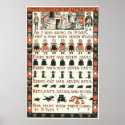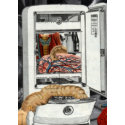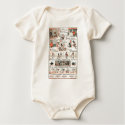Both these tips come from that 1940s Hint Hunt booklet. The first is on making glass baby bottles less slippery; the second on making drinking glasses with a better grip for small children (and, I dare say, for older folks too!).

Thursday, November 18, 2010
Better Grip For Non-Slip Glasses & Baby Bottles
Posted by Deanna Dahlsad
2
comments
Labels:
Food,
Household Tips,
Safety
![]()
Monday, November 15, 2010
Teaching Your Children To Sew
Posted by Deanna DahlsadYou readers know that I'm shocked by the lack of sewing instruction in schools -- and at home. While I've forgotten so much from my official home ec classes, I know how to do simple repairs -- but not many do.
Since I've been talking with artisan-crafter behind both I Sew Cute and As Luck Would Have It, I thought I'd ask her what she thought about it...
I realize as a crafter, you might want to sell finished product, but since you do sell those nifty patterns, I thought perhaps you could comment on this situation.
I grew up learning about sewing and knitting from my mom and Nana. My other grandma who didn't sew at all -- but she always encouraged me in my creativity. It was a good combination of watching and learning as well as being supported and encouraged. I was lucky to have that.
Since you have children, I'd also like to discuss crafting with children. Do you have an advice for teaching sewing at home? Any products, kits, etc., you'd recommend? For any/all ages.
To start kids off learning how to sew, I'd start them on lacing cards to get the hand coordination down as preschoolers.
Stringing beads is also a fine motor skill to prepare them for future sewing.

After lacing cards, I'd then move on to teaching them how to sew a button onto a piece of fabric, or sewing 2 pieces of fabric together by hand to make a simple pillow.
I don't believe sewing is just for girls either. My father and grandfather worked in leather and had heavy duty machines for sewing it. If my boy wants to sew, I'd encourage it!
What are the ages of your children? How many do you have?
I have a six year old boy and a four year old girl.
Aside from keeping them busy with creative activities (as opposed to passive entertainment like TV and video games), what other benefits do you see for children who make crafts and sew?
I know my kids are going to grow up to be happier people because of their love of working with their hands. The real benefits are they will never be bored, will have an outlet for expressing themselves, and will have satisfaction for contributing something to the world by using their creative voices, whatever they may be.
I think all children are naturally creative and it's up to us as parents to nurture that.
Not to mention, those kids will grow up able to sew their own buttons back on their shirts, mend a seam, or even hem a pair of jeans. And be able to teach their own children to do the same. *wink*
I'd like to thank June for spending so much time with me -- including sharing her vintage children's spoon collection!
2
comments
Labels:
Crafty,
Sewing
![]()
Wednesday, November 10, 2010
Vintage Coffee Percolator Tip
Posted by Deanna DahlsadAnother tip from that Hint Hunt booklet; this one about avoiding grounds in your coffee using a thimble:
1 comments
Labels:
Food,
Household Tips,
Vintage Living
![]()
Friday, November 5, 2010
This Week's Vintage Home Ec Links
Posted by Deanna DahlsadOver at Past Life, Miss CherryBubbles experiments to create a recipe for Apple Cider Pancakes.
The Retro Housewife has tips on apples.
At 50s Times, 50sGal shares vintage advice on planning, shopping, and budgeting meals.
And a very special "Thank you!" to Vixen Vintage for her lovely comments about this blog in her Learning From The Past post!
1 comments
Labels:
Cooking,
Food,
Guides,
Recipes
![]()
Wednesday, November 3, 2010
Living The Viva Vintage?, Or Just Plain Loco?
Posted by Deanna DahlsadHubby sent me this link to Jen But Never Jenn's 50s Housewife Experiment; he found it via this post at MetaFilter, which was anything but kind.
This made me think about addressing an underlying question about this blog: Do I live a vintage lifestyle?
The simple answer is, "No, I do not." (And if you've read any of my other blogs, especially Kitsch Slapped, you'd probably know that lol) But the more in-depth answer is that I pick and choose what tips and practices of the past fit the needs of my family and myself.
My reasoning, is two-fold. One, that I'm too well-aware of the unrealistic expectations of that time, for both genders, to pretend otherwise. As Jen mentioned, and I'm pretty sure I myself have written somewhere, is that the past is far too easily romanticized; we tend to recall and pine for the powerful love story of Casablanca, but forget the realities such as the actual pain of unrequited love and living with someone we are beholden to, but do not love -- let alone recall the wounds of war!
One, that I'm too well-aware of the unrealistic expectations of that time, for both genders, to pretend otherwise. As Jen mentioned, and I'm pretty sure I myself have written somewhere, is that the past is far too easily romanticized; we tend to recall and pine for the powerful love story of Casablanca, but forget the realities such as the actual pain of unrequited love and living with someone we are beholden to, but do not love -- let alone recall the wounds of war!
Two, I'm too busy to summarily reject out-of-hand modern conveniences which actually do the work more efficiently and even more cost effectively than if done the way our grandmothers did it.
While I'm too old to just pretend and play house, my age (an astonishingly old -- especially on the Internet! -- 46) and experience does provide me an interesting perspective...
It's true that some of us have overly romanticized the 1950s (or any era, really); but some of us have demonized the past as well. In the process, we've thrown the baby of helpful household tips out with the bathwater of modernism and/or feminism. This "either or" or "all or nothing" thinking has diminished the value of housewives and housework, and, in my opinion, many of the so-called conveniences are anything but -- they've only raised other economic, environmental and health problems, for individuals and our country as a whole.
I'm in the middle of reading a great book about the history of home economics which addresses much of this and, as I'll be reviewing it here, I'll wax on then.
For now I'll just summarize that there's a lot we can learn from the past, practical and otherwise, and I use this blog to help remind us all of it; it's up to each individual to decide what, if anything, is helpful enough for them to reclaim.
Image Credits: Housewife Marjorie McWeeney with Broom Amidst Display of Week's Housework at Bloomingdale's Store, photo by Nina Leen for LIFE magazine.
5
comments
Labels:
Vintage Living,
Women
![]()
Tuesday, November 2, 2010
Vintage Recipe For Corning Liquid & Irish Corned Beef And Cabbage
Posted by Deanna DahlsadThe following recipes for making up to six gallons of corning liquids and Authentic Irish Corned Beef & Cabbage comes from the amazing Bull Cook and Authentic Historical Recipes and Practices, by George Leonard Herter and Berthe E. Herter. (I may be sharing more from this book -- but not all will be at this blog because much of the text is far too unlikely to be practical. So please keep an eye on my other blogs, &/or follow me on Twitter!)

2
comments
Labels:
Books,
Cooking,
Food,
Recipes
![]()

















